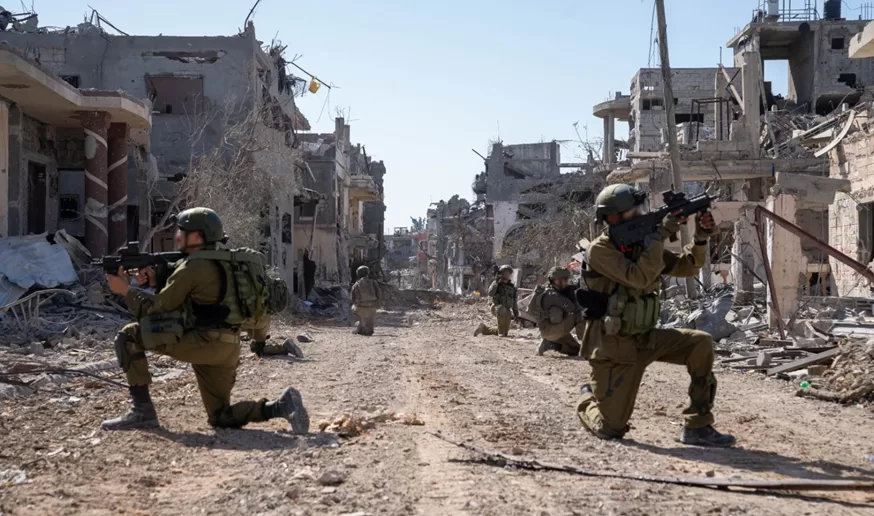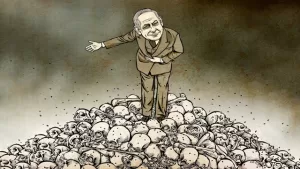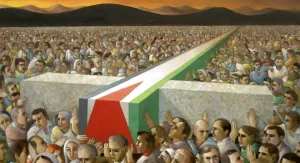❈ ❈ ❈
‘Complete Surrender’: How Gaza Defeated Israel and What it Means—Analysis
Ramzy Baroud
Israel’s National Security Minister Itamar Ben-Gvir accused the Israeli government of Benjamin Netanyahu of “a complete surrender to Hamas,” calling the Gaza ceasefire agreement a “surrender deal.”
For once, Ben-Gvir is right.
For over 15 months, the Israeli military has tried every possible strategy to achieve victory in Gaza, yet it has failed. Analysts will spend years trying to understand how a country with such advanced killing technologies could fail to subdue a group of fighters who make their own weapons, or more accurately, how a group of fighters, relying on improvised weapons, managed to defeat an entire arsenal provided to Israel by the United States, Britain, Germany, Italy, and many other Western and non-Western countries.
Gaza has been under a hermetic Israeli siege for nearly two decades, during which Israel has launched major wars on the region—starting in 2008 and culminating in the latest onslaught. This recent war, however, was not just another round of violence. It was genocidal in scope, a campaign of destruction unprecedented in the region’s history.
Israel will attempt, with the help of its allies in the media, to frame the Palestinian victory in Gaza as a defeat. Netanyahu and his allies within his extremist cabinet – with a few exceptions – will likely downplay the failure or attempt to distort the narrative.
These so-called “achievements” by Israel do not even qualify as tactical victories. On the contrary, Israel’s actions have caused the destruction of Gaza and led to countless civilian casualties, including women and children.
Israel assumed that by destroying Gaza, it would eradicate the resistance. However, that calculation was deeply flawed. The resistance in Gaza is directly tied to the Palestinian people. It’s not about eliminating a specific number of fighters but about the enduring bond between the people and the resistance itself.
This bond remained unbroken; in fact, it became even stronger. Without committing outright mass genocide—as in killing every Palestinian in Gaza—Israel could not extinguish the resistance. Some politicians, such as Israel’s Minister of Heritage Amihai Eliyahu, repeatedly made such a demand, calling for the dropping of a nuclear bomb on Gaza.
Ultimately, Israel failed, though it killed and wounded, in the estimation of the Lancet medical journal, hundreds of thousands of Palestinians.
This time, Israel’s failure cannot be dismissed as merely not achieving its objectives. The Israeli army suffered devastating losses—greater than in any military confrontation with Arab armies since Israel’s establishment in 1948.
These losses were inflicted by grassroots resistance groups that do not rely on alliances with major powers, such as the former Soviet Union, to sustain their fight. Instead, these groups rely on their own resources, their own people, and their own strategies.
The significance of this resistance lies in its introduction of a new model of anti-colonial struggle in the Arab world, unifying non-state actors—such as the Resistance in Gaza, Hezbollah in Lebanon, Ansarallah in Yemen, and other groups across the region—that fought with a single strategy. This unified approach succeeded in weakening Israel’s economy, overwhelming its army, and ultimately defeating it on the battlefield.
Israel has, in fact, been defeated. After 15 months of fighting, Israel surrendered to the Resistance. This surrender reflects Israel’s admission that it could neither reoccupy Gaza, destroy the resistance, ethnically cleanse Palestinians, counter regional resistance groups, nor sustain the war any longer.
As a result, Israel agreed to return to the same ceasefire terms that Hamas had accepted as early as May and again in July of last year. This marks a historic moment.
This defeat will have profound repercussions. It highlights the unbreakable and unified nature of the Palestinian Resistance. It reaffirms the people’s resolve to continue their struggle, drawing inspiration from the words of the great African-American leader Malcolm X: “By any means necessary.”
[Ramzy Baroud is a journalist and the Editor of ‘The Palestine Chronicle’. He is the author of five books. His latest is “These Chains Will Be Broken: Palestinian Stories of Struggle and Defiance in Israeli Prisons” (Clarity Press, Atlanta). Dr. Baroud is a Non-resident Senior Research Fellow at the Center for Islam and Global Affairs (CIGA), Istanbul Zaim University (IZU). Courtesy: Palestine Chronicle. The Palestine Chronicle website strives to highlight issues of relevance to human rights, national struggles, freedom and democracy.]
❈ ❈ ❈
The War Is Over: Hamas Reaps the Fruits of 7 October
The Cradle’s Palestine Correspondent
After 15 months of a brutal and relentless genocide that took the lives of over 50,000 Palestinians, a Gaza ceasefire has finally been reached. The truce deal marks a devastating victory for the Palestinian resistance, achieved at a staggering human cost, and a political loss for Israeli Prime Minister Benjamin Netanyahu and the occupation state.
Unless Netanyahu pulls an unexpected move, which seems improbable for various reasons – most of them tied to demands from the incoming administration of US President-elect Donald Trump – it is clear to all involved in Doha, Cairo, Istanbul, and Washington that the agreement to halt the Gaza genocide has been finalized and is now underway.
Sources familiar with the negotiations reveal to The Cradle that the announcement delay on 14 January stemmed from an Israeli “final attempt” to manipulate withdrawal maps. Tel Aviv sought to insert the term “withdrawal from populated areas,” which implied maintaining its forces in “open areas” near civilian zones.
This effort was thwarted by “decisive American pressure.” On 15 January, further delay arose from disagreements over who would announce the agreement: the Qataris, Americans, Egyptians, or a joint conference. “Everyone wants to pick the image of achievement, but the balance is weighted in favor of the Qataris,” explains one of the sources. In the end, Qatar announced the ceasefire due to its pivotal position in mediating the deal. A few hours later, US President Joe Biden also announced the ceasefire.
Two months prior, Qatar temporarily withdrew from mediation to secure a US mandate from the new administration. Washington, recognizing Qatar’s “distinguished relationship” with Hamas, sidelined Cairo and resumed negotiations in Doha instead.
The ceasefire will take effect on Sunday, 19 January, just one day before Donald Trump’s inauguration. This timing is partly attributed to US efforts to shape optics and partly to allow logistical preparations by the Israeli army in the Gaza Strip.
Key details of the agreement
Hamas and Israel have agreed to a phased approach, balancing both their immediate and long-term goals. The deal includes the release of 1,000 Palestinian detainees, including 250 prisoners serving life sentences, women, and minors under 19 years old. Israel also agreed to withdraw from key areas of the strip, notably the Netzarim and Philadelphi axes, facilitating the return of displaced Gazans to the north without preconditions.
A significant element of the agreement was Hamas releasing 33 or 34 Israeli prisoners still held in Gaza, out of a total of 98, representing a third of the remaining captives. Notably, this was achieved without providing Tel Aviv with prior disclosure of the hostages’ condition, whether alive or deceased.
For the first time, Israel publicly revealed the number of Gazan prisoners: 3,436, with 529 denied legal counsel – a mix of fighters and civilians, debunking the Israeli narrative throughout the war to have captured thousands of fighters.
Despite Israeli attempts to prioritize certain Shin Bet and Unit 8200 operatives in initial prisoner swaps, the agreed process ensures transparency. Prisoner release protocols, including pledges and documentation, began days prior, the sources inform The Cradle.
The withdrawal adheres to pre-7 October 2023 borders, averting Israeli attempts to establish buffer zones and achieve territorial encroachment – a significant victory for the Palestinian resistance. Hamas also secured commitments for reconstruction, including hospital rehabilitation, field medical teams, and unrestricted humanitarian aid.
This includes the re-opening of the destroyed Rafah crossing with Egypt, although Egyptian sources tell The Cradle it will likely be opened in March, while work is already underway to repair the Egyptian side. Qatar will sponsor 600 daily aid trucks, 200,000 tents, and 60,000 caravans. Moreover, Israel must limit air operations over Gaza to 8 to 10 hours daily in order to facilitate Palestinian search-and-rescue efforts.
Throughout the six-week implementation, Hamas will gradually release Israeli prisoners – three to four prisoners per week – an average of 19 in the first five weeks – and the remaining 14 or so at the end of the first phase, retaining 65 individuals as leverage for subsequent phases. The details of those phases will be negotiated later, provided that the Americans uphold their guarantee to prevent the return of war.
The first troop withdrawal phase, allowing displaced Palestinians to return to the north, from Al-Rashid al-Bahari Street to the west, begins on the seventh day of the ceasefire. By the 22nd day, Israel will fully withdraw, restoring freedom of movement for all Palestinians.
Netanyahu’s bitter pill
Over 15 months of total war, Netanyahu has faced numerous internal and external hurdles to reach this agreement. In the interim, the Israeli narrative of “absolute victory” has unraveled. Widely-touted promised gains, such as retaining the strategic Netzarim and Philadelphi corridors, have been abandoned, leaving Netanyahu and his extremist governing coalition grappling with a public relations crisis. The liberation of Palestinian prisoners and the reversal of territorial ambitions evoke memories of the 2011 exchange that freed 1,027 Palestinians for Gilad Shalit – a painful reminder for Israelis.
Israeli media’s reactions reflect this bitterness. “The pressure Trump is exerting right now is not the kind that Israel expected from him,” lamented the rightwing commentator Jacob Bardugo on Channel 14 on Monday. The network’s journalist Ariel Segal, close to Netanyahu, remarked, “It could be that we (Israel) are the first to pay the price of Trump’s election.” Meanwhile, a journalist ally of extremist Security Minister Itamar Ben-Gvir concedes that “Trump increased the pressure on Hamas to the point that Israel broke.”
To compensate, there are reports of an “American compensation package” offering Netanyahu political cover for this domestic defeat. It includes lifting sanctions on extremist settlers, shielding Israeli leaders from international legal action, and permitting major West Bank settlement expansions. Yet, compared to Tel Aviv’s far-reaching initial ambitions, such as annexing the West Bank or attacking Iran, these concessions appear diluted.
The late, martyred Hamas leader Yahya Sinwar, who spearheaded the resistance’s Operation Al-Aqsa Flood, emerges as a key figure in the context of a prison swap. According to Hamas sources, the resistance negotiated the ceasefire on Sinwar’s stringent terms, and in death, he achieved his goals. This will further glorify the man whose fight to the bitter end was captured in emotive images during his direct, defiant confrontation with the occupation forces.
His soldiers, unaware of his identity until after his martyrdom, viewed him as a symbol of resistance. Today, Israel faces the prospect of releasing hundreds of prisoners with life sentences and will be bitterly weighing the likelihood of future ‘Sinwars’ among them. For Israel, prisoners sentenced to life imprisonment are seen as having “blood on their hands,” signifying their perceived threat and resilience as formidable Palestinian figures.
A fragile victory
Despite unparalleled suffering – over 200,000 casualties, mass displacements, and Gaza’s near-total devastation – Palestinians are finding solace in halting the war and securing key concessions. The resistance’s steadfastness and Qatar’s deft diplomacy reshaped an agreement that, while imperfect, forestalls further bloodshed and displaces Israeli ambitions of long-term occupation.
However, the cessation remains precarious, hinging only on American guarantees and mutual adherence to terms. For Gaza’s people, scarred by war yet defiant, the deal symbolizes not just survival but a step toward reclaiming their dignity amid a continuing struggle.
When viewed alongside the key components of this agreement and juxtaposed with Israel’s objectives – the displacement of Gazans, the exile of resistance leaders, and the forcible retention of prisoners – the outcome marks a notable “achievement.”
This is particularly evident after over a year of relentless warfare, during which the occupation state seemed intent on perpetuating its presence in Gaza indefinitely. What complicates the narrative is the perception that the cessation of hostilities was largely driven by a “quasi-personal” decision by Donald Trump, who indirectly attacked Netanyahu during the process.
Yet, this outcome would not have been possible without the unwavering determination of the Palestinian resistance in Gaza. Their recent intensifying operations, especially on the front lines near Beit Hanoun, which exacted heavy death tolls on Israeli forces, played a crucial role in addition to the regional fronts opened by Hamas’s allies in the Axis of Resistance.
Nevertheless, these efforts alone did not directly prompt the war’s end. Gazans have endured horrors they liken to “doomsday scenes.” The toll includes 17,000 orphans and countless families erased from the civil registry.
On 16 January, one day after the announcement came, Netanyahu attempted to delay the approval of the ceasefire deal, blaming Hamas for “backtracking.” However, Hamas official Izzat al-Rishq stated the group remains “committed” to the ceasefire announced Wednesday. Israeli media attributed the delay to Finance Minister Bezalel Smotrich’s threats to leave the government in protest.
The people of Gaza are choosing to celebrate the agreement and its implications. Their joy and relief are visible not only in the diaspora and the West Bank but also in the streets of Gaza and among the makeshift tents they now call home, even before the agreement’s official declaration.
(Courtesy: The Cradle, an online news magazine covering the geopolitics of West Asia from within the region.)
❈ ❈ ❈
Jamal Kanj, in an article published in ‘The Palestine Chronicle’, Reaching Ceasefire in Gaza: A Tale of Trump’s Illusion and Biden’s Failure, adds:
President Joe Biden, flanked by his Secretary of State and Vice President, announced the ceasefire in Gaza with an air of accomplishment, framing it as a crowning achievement of his administration’s diplomatic efforts. However, this assertion is profoundly misleading. While the ceasefire was presented as a diplomatic victory, the truth reveals a far darker reality. For many, the Biden administration will not be remembered for brokering peace but for enabling and facilitating policies that allowed Israel’s genocide to continue unabated.
President Biden and Secretary Anthony Blinken’s legacy will be marked not by a ceasefire but by their role in providing and enabling Israel to drop 85,000 tons of bombs on Gaza—an amount that surpasses the combined bombings of Dresden, Hamburg, and London during World War II. Their tenure will be remembered for presiding over murdering or injuring 10% of Gaza’s population and the destruction of 86% of all building structures.
When students in Gaza eventually return to school after 15 months of devastation, they will face the grim effect of what the American-made bombs have wrought: 123 universities and schools reduced to rubble, murdering 750 academics and the loss of 130 scholars and university professors who once inspired hope and knowledge.
As aid trucks will be allowed to slowly roll into Gaza, the people will not forget the 300 humanitarian workers deliberately killed by Israel, nor the 160 journalists and media workers who risked—and lost—their lives attempting to broadcast the cries of a besieged population, only to have their voices fall on deaf ears and a world of dead conscious.
Amid the ruins of over 654 healthcare facilities, the memory of 1,000 selfless healthcare workers and some of Palestine’s finest medical doctors who perished in their efforts to save lives will remain seared into the collective consciousness. For the people of Gaza, this is not just a story of destruction but a testament to the world’s indifference and complicity in the face of a humanitarian catastrophe of unimaginable scale.
The current ceasefire agreement could have been secured months earlier. In May, President Biden proposed a similar framework that the Palestinians accepted. However, Netanyahu rejected it as a as “nonstarter,” prioritizing his political survival over ending genocide. Instead of holding Israel accountable or insisting on compliance with international humanitarian law, the Biden administration—led by the genocide facilitator, Secretary of State Blinken—chose to appease and embolden Netanyahu in his crimes.
Nonetheless, ending Israel’s war of genocide offers a fleeting sense of relief after 15 months of suffering. This, however, is less of a triumph to American diplomacy and more an indictment of systemic failures in the Biden’s foreign policy. Nor should it be seen as the success Donald Trump wants to project, but a reality more rooted in the abject weakness and failure of the self-proclaimed Zionist, Biden.
In this context, Trump’s allies have opportunistically seized the moment to frame the ceasefire as a vindication of his so-called strength in foreign affairs. However, such a claim is farther from the truth. The ceasefire was not the result of decisive U.S. intervention or diplomatic maneuvers but rather an Israeli failure to subdue the steadfast resistance of the Palestinian people, despite giving Netanyahu a carte blanche for over 15 months to achieve his elusive “victory.”
To this end, the ceasefire is a stark acknowledgment of Israel’s inability to impose its will, even with the unlimited U.S. military aid and diplomatic cover. Instead of securing the domination, the resistance from Gaza underscored the resilience and determination of the Palestinian people in the face of overwhelming odds. This outcome serves as a reminder that no amount of force or repression can extinguish the fight for justice and self-determination.
(Jamal Kanj is the author of Children of Catastrophe: Journey from a Palestinian Refugee Camp to America, and other books. He writes frequently on Arab world issues for various national and international commentaries.)




